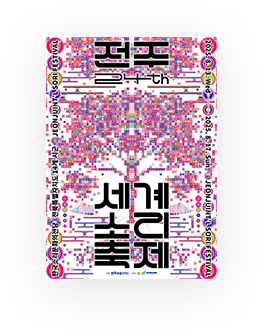d-day
D
+
291


2025. 8. 13. Wed - 2025. 8. 17. Sun

60 Minute
Free
All Ages Admitted
Various Jeonbuk-style Pangut Stages Plus Gangneung Nongak from Yeongdong Province!
Exciteful Pungmul Stages for Five Days of Sori Festival Period
Nongak (lit. farmers’ music) that has been traditionally performed to pray for the harmony, prosperity, and peacefulness of the village community became developed into Korea’s representative performing art genre. Nongak is a synthetic art from in which performers march or act while playing percussive instruments such as kkwaenggwari, jing, janggu, buk, sogo, etc.. The ensemble-format, rhythm, play style, costumes of nongak bands vary from village to village. It was designated as a UNESCO Intangible Cultural Heritage in November 2014.
During the 2024 Jeonju International Sori Festival period, a variety of pangut (lit. field for ritual-like performance) sub-styles from Jeonbuk Province will be performed. The audience will be able to meet Honam-udo nongak (from Iri and Gochang), Jeolla-jwado nongak (from Jinan), Baekjungnori (also known as Jeonju-gijeopnori) plus Gangneung Nongak from Yeongdong Province (i.e., the eastern part of Gangwon-do region). During the five days of Sori Featival, let us experience the excitement and beauty of traditional arts through enjoying this “pungmulgut (lit. percussive music-ritual) fever” performances that symbolize harmony, unity, and enthusiasm.
Iri Nongak
Iri Nongak, National Intangible Cultural Heritage No.11-3, is one of the representative forms among Honam-udo (eastern part of Jeolla region) of nongak performances. Iri Nongak differs from other regional styles in that it includes a variety of buponori and sogo-dance techniques for Sangsoe (lead kkwaenggwari player), and that it includes highly developed jangdan (rhythmic pattern) of janggu as well as body-movement. It makes relatively frequent use of slow melody, and every melody-chunk is delicately changed into variations during the performance, making the whole performance more colorful. In pungryugut and samchaegut parts, elaborate rhythmic techniques of “fastening and releasing” are found. Iri Nongak consists of the first, second, third madang (sequential part) and dwitgut. Dwitgut (i.e., the later part of performance) includes dodukjaebi-gut (grabbing thief), sangsoenori (sangsoe’s performance), seoljanggunori (standing performance with janggu), sangmonori and yeoldubalnori (performances with sangmo hat), ginori, etc..